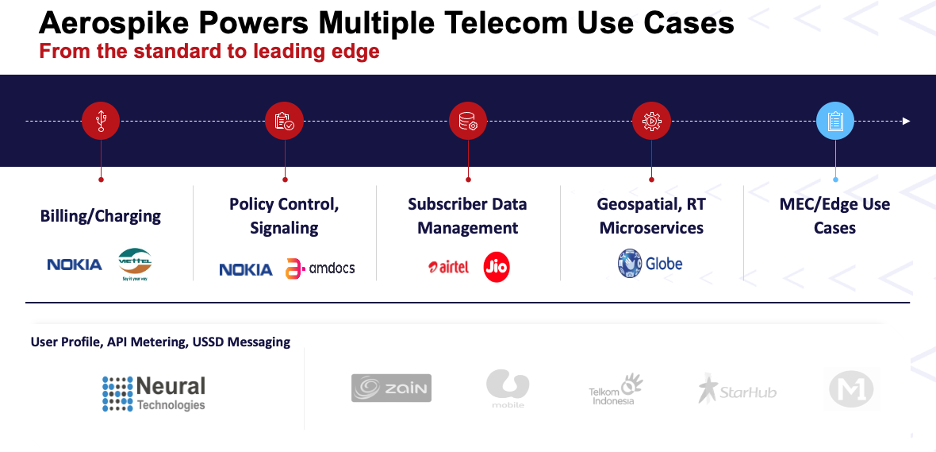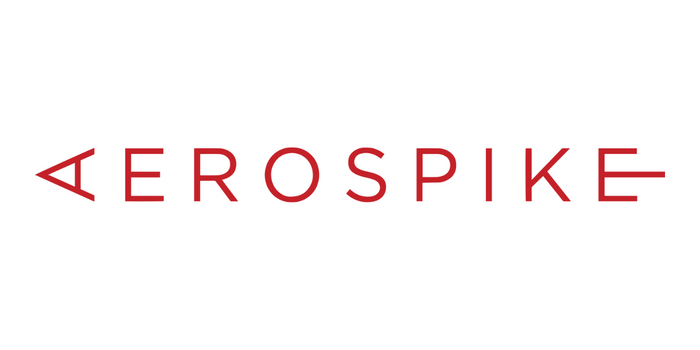blog

A versatile real-time data platform to future-proof your telecom use cases
By: Shahed Mazumder, Global Director, Telecom Solutions – Aerospike
Aerospike’s multi-model real-time data platform is known in the industry for its small footprint and low total cost of ownership (TCO), thanks to our patented Hybrid Memory Architecture (HMA). Today, our telecom customers use Aerospike for a wide range of use cases – from billing/charging to policy control, signaling to subscriber data management, and even geospatial real-time microservices. We also support traditional telecom use cases through partners such as Neural Technologies. There is a growing interest in Aerospike for data-heavy multi-access edge compute (MEC) use cases, where the sub-millisecond to single-digit millisecond response of the Aerospike Real-time Data Platform can contribute to the reduction of end-to-end latency experienced by end users.

Recently, there are also a lot of inbound queries from providers of subscriber profile databases (HLR for 3G, HSS for 4G, UDM/UDR for 5G).
But we can do so much more.
In this blog post, I will highlight a few key functionalities/capabilities of the Aerospike data platform that make it stand out. Let’s get into that in the context of telecom use cases-
Full-fledged document database
Aerospike Database 6 is the first expansion of our flagship NoSQL database beyond its initial key-value data model to include full document database capabilities, including the storage, indexing, and querying of JSON document data. Powered by the Aerospike Document API, Aerospike Document Database enables developers to create and store JSON document data as an Aerospike Collection Data Type (CDT) object that can be accessed, queried, and modified using a JSONPath syntax.
This recent blog post on leveraging a real-time document database articulates the trends and requirements around real-time unstructured data at scale. As telcos expand their customer interactions through a constant online/web presence and real-time applications, they have become gold mines of unstructured data at a massive scale, which is a sweet spot for a document database. Support for JSON, the de facto data model for the web, therefore offers a critical opportunity for modern data platform providers, and Aerospike is doing just that.
Implementation of graph database
A NoSQL graph database integrates heterogeneous data from a variety of sources and makes links between different datasets. It does this by focusing on the relationships between separate entities and then surmising new knowledge from the information on hand. We recently introduced Aerospike’s graph database offering that combines our database with Apache TinkerPop™, the most widely adopted graph computing framework.
Today, we already support a non-telco customer for their identity graph requirement, which is critical to their fraud detection and prevention use case. In the telco space, one existing customer and another key prospect are talking to us to test/explore our graph database capabilities in the context of segmentation and micro-targeting – the telecom use cases under consideration include what advertisement should be shown to whom based on that user’s social interaction.
Rich connector ecosystem for SQL access and full-text search
Aerospike recently announced our implementation of Aerospike Connect for Elasticsearch to allow developers to incorporate full-text search capabilities for real-time data. This follows our earlier announcement of Aerospike SQL Powered by Starburst, which made it possible for our customers to run massively parallel, complex SQL queries on the data stored in the Aerospike Real-time Data Platform.
Why is this important in a telecom use case? Telecom data is stored and accessed in a highly distributed manner. Ideally, it requires access technology without moving the data from its place. Also, telcos have enthusiastically embraced a microservices architecture. Our support for telecom microservices is helping one of our major customers in their transformation from a Communication Service Provider (CSP) into a Digital Service Provider (DSP).
As highlighted here, the release of Aerospike Connect for Elasticsearch and Aerospike SQL Powered by Starburst is part of the transformation of Aerospike from a database to a data platform. It builds on our existing portfolio of connectors to essential data pipeline components such as Kafka, Pulsar, JMS, Spark, and Trino. It also complements our already powerful query capabilities realized by our highly parallelized secondary indexes and precise Expressions.
Energy and cost savings in cloud deployments via support for Graviton
Last but not least, Aerospike’s total cost of ownership (TCO) advantage was boosted with the recent release of Aerospike 6.2, as Aerospike Database 6 became available on AWS Graviton. Graviton support further strengthens our partnership with AWS and dramatically reduces infrastructure costs for real-time applications, which, with the explosion of streaming data, have increasingly become more common in telecom. Graviton offers a dual benefit of greater energy efficiencies for certain CPU-intensive in-memory workloads and better cost performance. In a benchmark we ran with the support of AWS, the Aerospike Database processed 25M transactions per second on Graviton instances versus 21.1M transactions per second on equivalent x86_64 instances (an 18% improvement). The Graviton deployment also came out 27% less costly than the x86_64 one on an annual basis.
For more resources:
- Hear directly from a top Tier-1 Telco on their CSP to DSP transformation journey
- Check out what we bring to the table to enable data-heavy Multi-Access Edge Compute (MEC) use cases
- Join us in Bangkok from March 14-16 at TM Forum’s DTW Asia for our session with the Viettel Group on how a future-proof charging infrastructure is allowing Viettel to deliver a seamless digital customer experience
Sponsored by:

